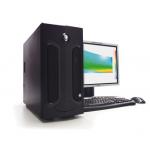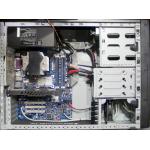Alien on the Desktop
We took an Alienware MJ-12 workstation for a spin and liked what we saw.
Latest News
January 1, 2006
By Mark Clarkson
Known for its high-end, custom gaming systems, Alienware is making forays into the workstation market. To see how well this Miami, Florida-based company was leveraging its specialized expertise for the product design and engineering markets, we decided to test out a new system.
I received just the basics from Alienware: the MJ-12 5500i computer tower without monitor or speakers. The only peripherals included a 5-button Microsoft IntelliMouse, and a branded version of the Microsoft Multimedia keyboard, all black with chrome buttons across the top for easy access to documents, websites, video clips, and e-mail. Buttons for volume and playback controls are also built right into the keyboard, and toggle-able function keys for one-touch access to common Windows commands (open, close, undo, help, spell check, etc.).
|
|
| The Alienware MJ-12 5500i. |
It seems a small thing, but I love the mouse pad Alienware ships with this system: a hard plastic board, mounted in a sort of non-skid rubber tray. The pad itself is reversible within the tray; one side has a fine, rough texture, while the other side is smooth. It really added to the mouse’s sensitivity; I had to dial my mouse’s speed down a notch or two when using it.
Case and Guts
Alienware is known for gaming rigs and their cases can be a bit garish. But aside from the chrome alien-head logo on the front bezel and the pretty purple power lights, this system’s look is all business—flat black sheet metal. The case is big and beefy (22 in. x 17 in. x 7 in.) fronted by a one-inch-deep locking bezel. The bezel itself is plastic, and folds out of the way to the side of the case on a set of cool plastic hinges that you will be sure to break with an errant kick if you put the system under your desk, which I promptly did (sorry, Alienware!).
Inside the locking case, which can be opened without tools, everything is nice and neat with all the wires tied together and hung neatly out of the way. The 650-watt power supply provides lots of juice for future expansion, and there’s plenty of room inside for more drives and any really, really big PCI cards you may want to install.
|
|
| You can get at the interior of the Alienware MJ-12 5500i tower without the use of tools; and it is roomy and neat, offering plenty of room for future expansion. |
The system CPU features a positively gargantuan heat sink tower, bleeding heat directly into a duct leading to a beefy 120mm fan on the back. There’s another 120mm fan drawing air in from the front to make sure there’s plenty of airflow keeping everything cool. But it sure is noisy.
Dual Performance
Overall, the system’s performance was a happy surprise. A quick glance at the spec sheet left me feeling a bit disappointed. A 2.8GHz Pentium, one gigabyte of system RAM, and a mid-range video card with a meager 128MB of RAM. In fact, that sounded suspiciously like the specs on my venerable Dell desktop, which is no longer anywhere near the cutting edge of technology.
Closer examination proved that the CPU was in fact the Pentium D—Intel’s new, dual-core chip, which basically sandwiches two Pentium IV processors, each with their own 1MB L2 cache, into a single package, making the system, in essence, a twin-processor rig. (Read more about the Pentium D by clicking here.)
Whether you would be better off with a single, faster processor depends a lot on your work style, and the applications you run. If you spend all day working on a single, non-multithreaded application, you may be better off spending the money on a faster CPU or more RAM. Keep in mind, though, the imminent release of Windows Vista, with its built-in support for multithreading.
If you, like me, multitask all day long, running Rhino and AutoCAD and Photoshop and Outlook, all at the same time, then the Pentium D will serve you well. (Though you should probably still invest in more RAM.) Switching between multiple running applications was surprisingly smooth.
Dual-core is a real plus if your applications are multithreaded like 3D Studio VIZ and MAX. They can effectively use multiple processors. Some applications, such as Photoshop and AutoCAD Inventor, are not actually multithreaded, but have some components that are. Doing a final render in Rhino 3D, for example, wasn’t significantly faster than it is on my own 2.8GHz system. Filtering large images in Photoshop, on the other hand, went nearly twice as fast.
FireGL V5000
The real surprise in the package is the video card: an ATI PCI Express FireGL V5000. Primarily known for consumer gaming products, ATI is making a push into the MCAD/Workstation market.
The FireGL V5000 is a mid-range card retailing for between $300 and $350. I wasn’t expecting much from it, especially with its meager 128MB of RAM (albeit GDDR3). But this card soon made a believer of me. It pushes pixels like nobody’s business. I had a hard time taxing it at all with everyday CAD tasks; I finally had to resort to playing some current, high-end games to clog up its six geometry engines and eight pixel pipelines. (I know: it’s a hard job, but somebody’s got to do it.) Applications like Rhino, Maya, and Photoshop never hiccuped. I suspect that the 1GB of system RAM will prove a limitation before I overrun the card’s capabilities.
Although I only tested the system with a single monitor, the V5000 has twin DVI outputs for dual monitors or high-resolution dual-link connections .
Summary
Overall, I really like this machine. It’s peppy. The components are all top-notch and there’s plenty of room and power for future expansion. The base system is priced at $1,589. My review system’s price tag of $2,338 seems more than fair; I priced similarly equipped systems from other manufacturers at nearly $4,000. Even if you aren’t a gamer, Alienware is worth a look.
Writer and artist Mark Clarkson’s latest book is Photoshop Elements by Example. Visit him on the Web at markclarkson.com or send e-mail about this article by clicking here. Please reference “Alieware January 2006” in your message.
Alienware MJ-12 5500i At A Glance
Processor: 2.8GHz Pentium D 820
Operating System: Microsoft Windows XP Pro
Motherboard: Intel D955XBK
Power Supply: 650-watt ATX2.0
System Memory: 1024MB DDR2 PC5300
Video: ATI Fire GL V5000 PCIe w/128 MB GDDR3
Audio: Intel Integrated High-Definition Audio 955X
Hard Drive: Deskstar 250Gb with 8MB cache serial ATA
Optical Drive: Lacie 16x dual layer DVDR/W drive with Lightscribe
Removable Storage: 1.44MB floppy
The base system comes with an Intel Pentium 4 Processor 640 w/HT technology 3.2GHz 800MHz FSB 2MB; 512MB dual channel DDR2 SDRAM at 533MHz; 2 x 256MB; an NVIDIA Quadro FX 330 PCI-E 64MB DDR graphics accelerator; and a 16x DVD-ROM drive with software DVD decoder.
Contact Information
Alienware Corp.
Miami, FL
Subscribe to our FREE magazine, FREE email newsletters or both!
Latest News
About the Author
Mark ClarksonContributing Editor Mark Clarkson is Digital Engineering’s expert in visualization, computer animation, and graphics. His newest book is Photoshop Elements by Example. Visit him on the web at MarkClarkson.com or send e-mail about this article to [email protected].
Follow DE







